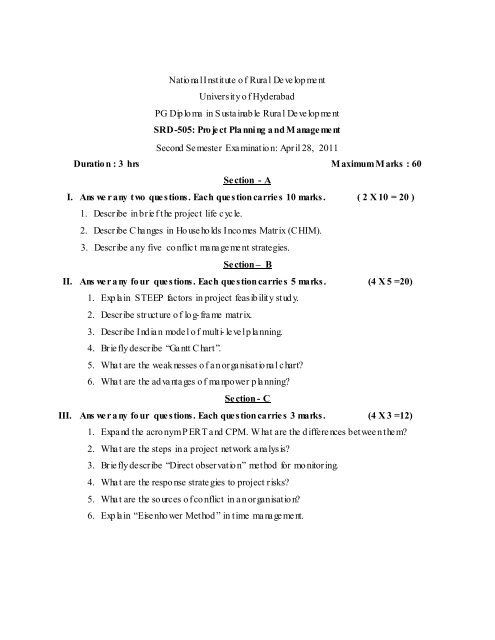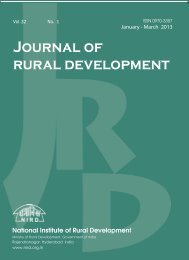PGDSRD Third Batch - Second Semester -Model Question Papers
PGDSRD Third Batch - Second Semester -Model Question Papers
PGDSRD Third Batch - Second Semester -Model Question Papers
- No tags were found...
Create successful ePaper yourself
Turn your PDF publications into a flip-book with our unique Google optimized e-Paper software.
Natio nal Institute o f Rural Develop mentUniversity of HyderabadPG Diplo ma in S ustainable Rural DevelopmentSRD-505: Pro ject Pla nning a nd Management<strong>Second</strong> <strong>Semester</strong> Examination: April 28, 2011Duratio n : 3 hrs Maximum Marks : 60Se ction - AI. Ans we r any two questions. Each question carries 10 marks. ( 2 X 10 = 20 )1. Describe in brief the project life cycle.2. Describe C hanges in Househo lds Inco mes Matrix (CHIM).3. Describe any five co nflict ma nagement strategies.Se ction – BII. Ans wer any four questions. Each question carries 5 marks. (4 X 5 =20)1. Explain STEEP factors in project feasib ility stud y.2. Describe structure o f lo g-frame matrix.3. Describe Indian model of multi- level planning.4. Briefly describe “Gantt C hart”.5. What are the weak nesses of an organisational chart?6. What are the ad vantages of manpower p lanning?Se ction - CIII. Ans wer any four questions. Each question carries 3 marks. (4 X 3 =12)1. Expand the acronym P ERT and CPM. What are the d ifferences between them?2. What are the steps in a project network analysis?3. Briefly describe “Direct observation” method for mo nitoring.4. What are the respo nse strategies to project risks?5. What are the so urces of conflict in an organisatio n?6. Explain “Eisenhower Method” in time management.
Se ction – DIV. Ans wer all questions. Each question carries 2 marks. (4 X 2 =8)1. What is major output fro m planning p hase of a project?2. What are the guiding principles for brainstorming?3. What is “P seudo-conflict”?4. What is “Time Log”?
Natio nal Institute of Rural DevelopmentUnive rsity of Hyde ra badPG Di pl oma i n Sust ai nabl e Rur al Devel opment SRD – 506:Stakehol ders i n Rural Devel opment <strong>Second</strong> <strong>Semester</strong>Exa minatio n: April 29, 2011Duration: 3 hrs . Maximum M arks : 60Section – AI. Ans we r any two questions. Each ques tion carries 10 marks (2 x 10 = 20)1. What is stakeholder analys is and how is it useful in susta inable rural deve lopment?Discuss its pr inc iples and different steps involved in its analysis.2. Discuss different types of cooperatives and their structural and functional basis intheirclassif ication.3. Delineate the role of institutiona l f inance in rural deve lopment.Section – BII. Ans we r any four ques tions . Each question carries 5 marks. (4 x 5 = 20)1. Describe princ iples of partnership2. Explain Consumer Protection Act and its salient features3. Discuss different farmer organisations and outline the steps in their formation4. What is Role of agricultura l cooperatives in rural deve lopment ?5. Describe the contribution of community based microfinance system in India6. Explain conflicts and their resolution in traditiona l societiesSection - CIII. Ans we r any four ques tions . Each question carrie s 3 marks. (4 x 3 = 12)1. What are problems of consumer cooperatives2. Describe objectives of Regiona l Rural Banks3. What are different stages of regulatory system for MFIs ?4. Describe ten pillars of SHG-Bank Linkage Programme5. Describe types of conflicts over resource management6. Write a Note on peoples’ organisation and contemporary system of conflict managementSection-DIV. Ans we r all questions. Each ques tion carries 2 marks . (4 x 2 = 8)1. Define Public-Private partnership2. What is Active Price Policy ?3. Define microfinance4. Define self-help groups
NATIONAL INSTITUTE OF RURAL DEVELOPMENTUNIVERS ITY OF HYDERABADSRD 507 Appropriate Technologies and Practices for S ustainable Development<strong>Second</strong> <strong>Semester</strong> Examination (April 30, 2011)Duration: 3 hourMaximum Marks:60Se ction- AI. Ans we r any of 2 questions. Each question carries 10 marks .(2X10=20)1. Explain the vision, components and framework o f National e-governance plan inIndia2. Explain the strategies adopted b y the Go vernment of India for energymanagement3. Discuss the various issues related to agrarian crisis in Ind iaSe ction- BII. Ans wer a ny 4 questions. Each question carries 5 marks .(4X5=20)1. Explain the various vegetative methods o f so il and water conservation2. Explain how rural industrialization helps poverty alleviation3. Discuss about the organizational set up o f watershed management in India4. Define GIS. Explain the elements o f GIS5. Elaborate the b iodiversity conservation for sustainab le agriculture6. How mud based techno logies can be effectively used in rural housing?Se ction- CIII. Ans wer any 4 questions. Each question carries 3 marks .(4X3=12)Write a paragraph (5-6 sentences) o n the fo llowing:1. Benefits o f agro-processing ind ustries2. Green buildings3. Issues in rural electrificatio n4. Limitations of organic farming5. PMGSY6. Village K nowledge Centres
Se ction- DIV. Ans wer all questions. Each question carries 2 marks .(4X2=8)Briefly explain (in 2 or 3 sentences) the following:1. Rural Telephony2. Total Sanitatio n Campaign3. Digital divide4. Kyoto Protoco l
















